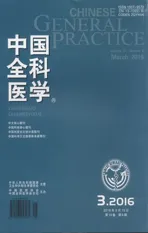脓毒症性急性肾损伤患者T淋巴细胞内三磷酸腺苷水平变化及其与肾功能转归的关系
2016-05-16朱潮涌毛明锋黄甘霖鲍晓红
朱潮涌,李 洁,毛明锋,黄甘霖,鲍晓红,金 烈
323000浙江省丽水市中心医院肾内科
·论著·
朱潮涌,李 洁,毛明锋,黄甘霖,鲍晓红,金 烈
323000浙江省丽水市中心医院肾内科
【摘要】目的探讨T淋巴细胞内三磷酸腺苷T cell-iATP)水平预测脓毒症并发急性肾损伤(AKI)患者预后的价值。方法前瞻性选择2013年7月—2014年12月于丽水市中心医院ICU、感染科及肾内科住院的脓毒症并发AKI患者69例为研究对象,分别于入组0、48、96 h检测患者T cell-iATP水平。根据肾功能临床转归情况将患者分为肾功能完全恢复组(18例)、肾功能部分恢复组(38例)、依赖透析组(4例)和死亡组(9例)。结果各组eGFR、功能衰竭脏器数量、AKI分期及0、48 hT cell-iATP水平比较,差异有统计学意义(P<0.05)。多分类Logistic回归分析结果显示,相对于预后不良(依赖透析或死亡),eGFR、功能衰竭脏器数量和48 hT cell-iATP水平为肾功能完全恢复、肾功能部分恢复的影响因素(P<0.05)。ROC曲线分析显示,48 hT cell-iATP水平预测脓毒症并发AKI患者预后的ROC曲线下面积为0.926(P<0.01),取48 hT cell-iATP临界点为344.2 μg/L时,灵敏度为92.3%,特异度为87.5%。结论T cell-iATP水平低的脓毒症患者肾功能恢复良好,脓毒症患者早期T cell-iATP水平是肾功能转归的预测指标。
【关键词】脓毒症;急性肾损伤;T 淋巴细胞; 临床转归


1对象与方法
1.1研究对象前瞻性选择2013年7月—2014年12月于丽水市中心医院ICU、感染科及肾内科住院的脓毒症并发AKI患者69例为研究对象,均符合2001年美国胸科医师学会(ACCP)和重症医学会(SCCM)脓毒症的诊断标准[4];根据急性肾损伤网络(AKIN)工作小组标准[5],1期25例,2期20例,3期24例。排除标准:(1)年龄<18岁;(2)有慢性肾脏病史;(3)合并免疫缺陷性疾病、恶性肿瘤。
1.2方法
1.2.1临床资料测量患者身高、体质量,计算体质指数(BMI)。检测血清肌酐(Scr)水平,根据肾脏病饮食修正公式(MDRD)估算肾小球滤过率(eGFR),eGFR=186-1.154×Scr×年龄-0.203(女性则×0.742),记录高血压史、糖尿病史、细菌培养、功能衰竭脏器数及肾功能转归等临床资料。

1.2.3治疗患者在治疗原发病基础上予抗感染、液体复苏、控制血糖、营养支持等综合对症治疗,出现呼吸衰竭者予机械通气治疗,出现难治性高血钾症、Scr>3 mg/dl和/或尿素氮>100 mg/dl、尿量减少导致的液体超负荷中的1项及以上者予血液净化治疗。
1.2.4肾功能临床转归的判定患者入组后28 d进行肾功能转归的判断,eGFR正常判定为肾功能完全恢复,eGFR持久下降但不需肾脏替代治疗判定为肾功能部分恢复,eGFR持久下降且需长期肾脏替代治疗判定为需依赖透析。根据肾功能临床转归情况将患者分为肾功能完全恢复组(18例)、肾功能部分恢复组(38例)、依赖透析组(4例)和死亡组(9例)。

2结果


表2脓毒症并发AKI患者预后影响因素的多分类Logistic回归分析
Table2MultivariableLogisticregressionanalysisoffactorsinfluencingtheprognosisofSIAKIpatients
注:选择预后不良(依赖透析或死亡)作为参照




3讨论



作者贡献:朱潮涌进行课题设计与实施、资料收集整理、撰写论文、成文并对文章负责;李洁、毛明锋、黄甘霖、鲍晓红进行课题实施、评估、资料收集;金烈进行质量控制及审校。
本文无利益冲突。
参考文献
[1]Kribben A,Herget-Rosenthal S,Pietruck F,et al.Acute renal failure-an review[J].Dtsch Med Wochenschr,2003,128(22):1231-1236.
[2]Bagshaw SM,Uchino S,Bellomo R,et al.Septic acute kidney injury in critically ill patients:clinical characteristics and outcomes[J].Clin J Am Soc Nephrol,2007,2(3):431-439.
[3]Bagshaw SM,Lapinsky S,Dial S,et al.Acute kidney injury in septic shock:clinical outcomes and impact of duration of hypotension prior to initiation of antimicrobial therapy[J].Intensive Care Med,2009,35(5):871-881.
[4]Levy MM,Fink MP,Marshall JC,et al.2001 SCCM/ESICM/ACCP/ATS/SIS international sepsis definitions conference[J].Intensive Care Med,2003,29(4):530-538.
[5]Mehta RL,Kellum JA,Shah SV ,et al.Acute kidney injury network:report of an initiative to improve outcomes in acute kidney injury[J].Crit Care,2007,11(2):R31.
[6]Dabrowski W,Kotlinska-Hasiec E,Schneditz D,et al.Continuous veno-venous hemofiltration to adjust fluid volume excess in septic shock patients reduces intra-abdominal pressure[J].Clin Nephrol,2014,82(1):41-50.
[7]Zarbock A,Gomez H,Kellum JA.Sepsis-induced acute kidney injury revisited:pathophysiology,prevention and future therapies[J].Curr Opin Crit Care,2014,20(6):588-599.
[8]Suh SH,Kim CS,Choi JS,et al.Acute kidney injury in paients with sepsis and septic shock:risk factors and clinical outcomes[J].Yonsei Med J,2013,54(4):965-972.
[9]Hotchkiss RS,Nicholson DW.Apoptosis and caspases regulate death and inflammation in sepsis[J].Nat Rev Immunol,2006,6(11):813-822.

[11]Schenk U,Frascoli M,Proietti M,et al.ATP inhibits the generation and function of regulatory T cells through the activation of purinergic P2X receptors[J].Sci Signal,2011,4(162):ra12.
[12]Hotchkiss RS,Karl IE.The pathophysiology and treatment of sepsis[J].N Engl J Med,2003,348(2):138-150.
[13]Devarajan P.Update on mechanisms of ischemic acute kidney injury[J].J Am Soc Nephrol,2006,17(6):1503-1520.
[14]Martina MN,Noel S,Bandapalle S,et al.T lymphocytes and acute kidney injury:update[J].Nephron Clin Pract,2014,127(1-4):51-55.
[15]Dai X,Zeng Z,Fu C,et al.Diagnostic value of neutrophil gelatinase-associated lipocalin,cystatin C,and soluble triggering receptorexoressed on myeloid cells-1 in critically ill patients with sepsis-associated acute kindney injury[J].Crit Care,2015,19:223.
[16]Huo W,Zhang K,Nie Z,et al.Kidney injury molecule-1 (KIM-1):a novel kidney-specific injury molecule playing potential double-edged functions in kidney injury[J].Transplant Rev (Orlando),2010,24(3):143-146.
[17]Lahoud Y,Hussein O,Shalabi A,et al. Effects of phosphodiesterase-5 inhibitor on ischemic kidney injury during nephron sparing surgery: quantitative assessment by NGAL and KIM-1[J].World J Urol,2015,33(12):2053-2062.
[18]Torregrosa I,Montoliu C,Urios A,et al. Urinary KIM-1, NGAL and L-FABP for the diagnosis of AKI in patients with acute coronary syndrome or heart failure undergoing coronary angiography[J].Heart Vessels,2015,30(6):703-711.
[19]Wang XZ,Jin ZK,Tian XH,et al.Increased intracellular adenosine triphosphate level as an index to predict acute rejection in kidney transplant recipients[J].Transpl Immunol,2014,30(1):18-23.
(本文编辑:吴立波)
ZHUChao-yong,LIJie,MAOMing-feng,etal.
DepartmentofNephrology,LishuiCentralHospital,Lishui323000,China
【Abstract】ObjectiveTo investigate the value ofT cell-iATP level in the prediction of the prognosis of sepsis patients complicated with acute kidney injury (AKI).MethodsFrom July 2013 to December 2014,a total of 69 sepsis inpatients complicated with AKI in the ICU,the Department of Infectious Disease and Nephrology in Lishui Center Hosipital were enrolled in this prospective study.The levels ofT cell-iATP at 0 h,48 h and 96 h after onset of SIAKI were detected.According to the prognosis of acute kidney injury (AKI),the subjects were divided into four groups:complete renal recovery group(18 cases),partial renal recovery group(38 cases),dialysis dependency group(4 cases) and death group (9 cases).ResultsThe four groups were significantly different in estimated glomerular filtation rate(eGFR),the number of visceral organs with function failure,and numbers of patient in each stage of AKI and the levelsT cell-iATP at 0 and 48 h (P<0.05).Multivariable Logistic regression analysis indicated that eGFR,the number of visceral organ with function failure and the levels ofT cell-iATP(48 h)were influencing factors for the complete recovery and partial recovery of renal function (P<0.05),compared with unfavorable prognosis (dialysis dependency or death).ROC curve analysis showed that the AUC ofT cell-iATP(48 h) predicting the prognosis of sepsis patients complicated with AKI was 0.926(P<0.01),with a sensitivity and a specificity as 92.3% and 87.5% respectively at a critical point of 344.2 μg/L forT cell-iATP(48 h) level.ConclusionSepsis patients with lowerT cell-iATP level have better recovery of renal function,andT cell-iATP level of patients with early-stage sepsis may serve as a predictor for the renal function outcome.
【Key words】Sepsis;Acute kidney injury;T lymphocyte;Clinical outcomes
通信作者:金烈,323000浙江省丽水市中心医院肾内科;E-mail:carrol_506@hotmail.com
【中图分类号】R 631R 692.5
【文献标识码】A
doi:10.3969/j.issn.1007-9572.2016.08.006
(收稿日期:2015-04-22;修回日期:2016-01-12)
·脓毒症性急性肾损伤专题研究·
